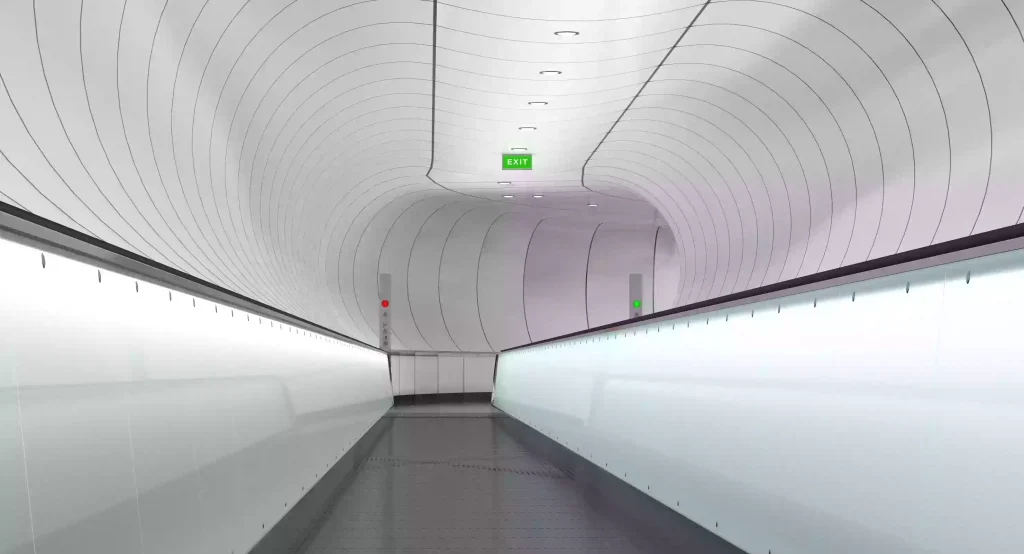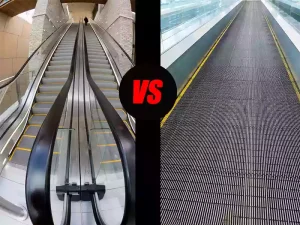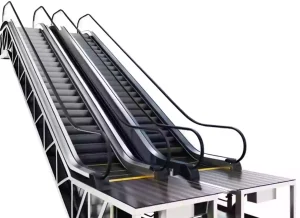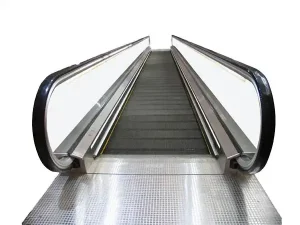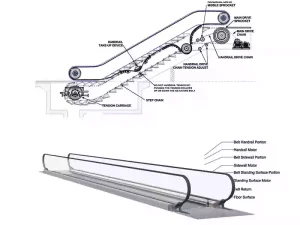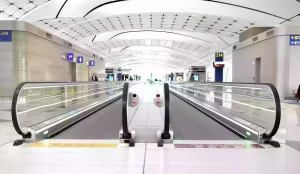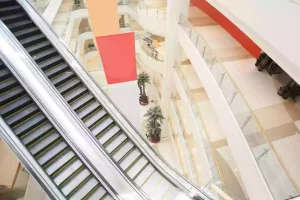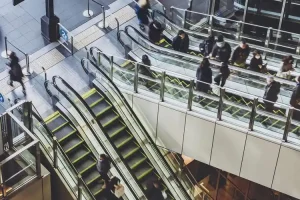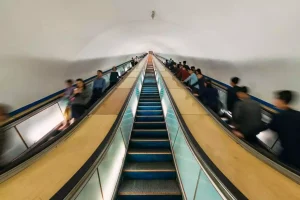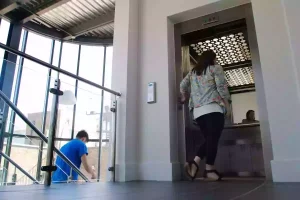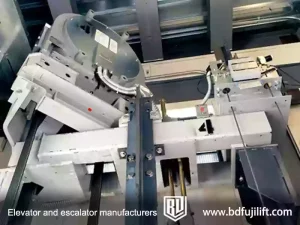We often see moving walkways and escalators in shopping malls and public transportation. Although both devices are designed to efficiently transport people, many people confuse the two. In fact, there are obvious differences between them. Next, let’s take a look at the main differences and similarities between moving walkways and escalators, as well as the application sites where each is suitable.
What Is the Difference Between Moving Walkways and Escalators?
In simple terms, moving walkways (also known as travelators or moving sidewalks) are flat or slightly inclined “conveyor belts” that often appear in airport corridors, while escalators have steps to help you move up and down between floors.
At first glance, these two devices look similar, but their functions are very different:
Escalator: An inclined device with steps that is suitable for vertical transportation between different floors.
Moving Walkway: A flat or slightly inclined conveyor belt used to help people move horizontally over long distances.
Travelator is specially designed to support “standing + walking”, allowing passengers to move faster in airport corridors or corridors. Escalators are only used for passengers to move up and down, and walking on the equipment is not recommended.
We can also quickly see the difference between moving walkways and escalators through the table below.
| Feature | Moving Walkway / Travelator | Escalator |
|---|---|---|
| Surface | Flat belt | Moving steps |
| Inclination | 0–12 degrees | 30–35 degrees |
| Common Location | Airports, exhibition centers | Shopping malls, train stations |
| Accessibility | Wheelchair and stroller friendly | Limited (step-based surface) |
| Also Known As | Moving sidewalk, moving walk | — |
In general, if you want people to move long distances on the same floor, a moving walkway is an ideal choice; if you need to go up and down between floors, an escalator is more suitable.
What Are the Similarities Between Moving Walkways and Escalators?
Although moving walkways and escalators have different uses, they have many similarities in core structure and operational logic. Both are automated pedestrian transportation equipment. Here are the common points between them.
Similar Machinery and Operation Mechanism
Based on Conveyor Belt Structure: Both operate through an electric conveyor system, but escalators are rotating stairs, while moving walks are continuous flat belts.
Continuous Operation: Unlike elevators, they can operate continuously, suitable for crowded areas and convenient for passengers to use at any time.
Synchronous Handrails: Whether riding a travelator or an escalator, the handrails will move synchronously with the platform to improve stability.
Safety Mechanism: Both are equipped with basic safety devices such as emergency stop buttons, motion sensors, and anti-pinch guards.
Similar Installation Environments and Usage Scenarios
Installation Locations: Both systems often appear in the same places, such as airports, subway stations, and large shopping malls, and they are responsible for transporting people in different directions.
Improved Traffic Efficiency: They are both designed to reduce crowd congestion and improve traffic efficiency, especially for the elderly, people carrying luggage, or people with limited mobility.
Although one is “up and down movement” and the other is “horizontal travel”, moving walks and escalators follow similar design principles, both for safer and more efficient transportation of people and passengers.
How Do Moving Walkways and Escalators Work? What Are the Structural Principles?
Although they have different uses, they share common engineering principles. The core structure is as follows:
Power System: The motor drives the chain or transmission belt to operate
Conveying Mechanism: The steps or flat belts and handrails run synchronously.
Support Structure: Installed in an inclined or horizontal steel frame structure
Control System: Sensors control speed, emergency stop, and fault response
The internal differences can be more intuitively understood through the structural profile. Because escalators bear vertical loads, they require stronger anchoring structures, while moving walks require longer installation spaces and more stable supports.
What Are the Differences Between Moving Walkways and Escalators in Terms of Safety?
Quick Preview Table of Safety Features of Escalator Moving Sidewalks:
| Safety Feature | Escalator | Moving Walkway |
|---|---|---|
| Anti-slip Surface | ✅ Yes | ❌ No |
| Emergency Stop Buttons | ✅ At both ends | ✅ At both ends |
| Skirt Guards | ✅ Standard | ✅ Standard |
| Speed Limiter | ✅ Required | ✅ Required |
| Wheelchair-Friendly | ❌ Limited | ✅ Fully accessible |
Due to the presence of steps and inclination angles, escalators are more prone to pinching or falling accidents, so more safety designs are applied.
Where Are Moving Sidewalks Usually Used?
Moving sidewalks are commonly used in the following scenarios:
Airports (such as boarding gates, baggage claim areas)
Passage connections in subways or train stations:
Exhibition halls, hospitals, and other places where long distances need to be walked
Are Moving Sidewalks and Escalators the Same Speed? Which One Is Faster?
After understanding the structure, purpose, and safety of moving sidewalks and escalators, another issue that is often of concern is their operating speed. After all, for places with high traffic, transportation efficiency is directly related to user experience. So, are the speed performances of these two devices the same? Which one can get passengers to their destination faster? You can see the data below.
- Escalator: 0.5 – 0.75 m/s
- Moving Sidewalk (Moving Walk): 0.7 – 0.9 m/s
From the data, escalators are faster, but the real advantage of moving walks is that you can walk while standing, which is more efficient.
Which Is Safer, a Moving Walkway or an Escalator?
In addition to speed, safety is also an important criterion for evaluating moving walkways and escalators. Different structural designs and usage methods will directly affect the safety experience of passengers in actual use. Whether it is the elderly, children, or passengers carrying luggage or strollers, the safety performance of the equipment will affect their travel choices. We compare the safety of the two from multiple angles, please continue reading.
User Behavior: Escalators require a stable standing posture, while sidewalks support walking
- Maintenance Frequency: Escalators require more frequent maintenance due to their complex structure
- Mechanical Structure: Moving sidewalks have a simpler structure and a lower probability of failure
How to Choose Between Moving Walkways and Escalators?
When to Choose Moving Sidewalks:
- The horizontal distance is long, and the traffic efficiency needs to be improved.
- There are wheelchairs, strollers, suitcases, and other equipment in the crowd.
When to Choose Escalators:
- Need to connect different floors.
- Limited space and inclined passages are required.
There are also users on Reddit who clearly stated that “I prefer sidewalks when traveling with children, and I don’t worry about steps when pushing strollers.” Therefore, if the main population of your building is mothers with children, then we must focus on their needs in this regard.
Moving sidewalks and escalators are good partners with a “clear division of labor”. Moving sidewalks are suitable for places where you need to save energy and pull luggage, while escalators are the best solution for vertical traffic, especially in compact buildings. They are irreplaceable.
✅ Tips:
If you are designing a public space, just ask yourself two questions:
Do users need to go up and down stairs? → Use escalators
Do users need to walk long distances? → Choose moving walkways
If you are still struggling to decide which one to choose, you may wish to contact professional moving walkway and escalator manufacturers such as BDFUJI. They will recommend the most suitable transportation solution based on your building layout and passenger flow.


